Attached files
| file | filename |
|---|---|
| EX-99.2 - CORPORATE STRATEGY PRESENTATION - TRANSATLANTIC PETROLEUM LTD. | d374244dex992.htm |
| 8-K - FORM 8-K - TRANSATLANTIC PETROLEUM LTD. | d374244d8k.htm |
 Annual General
Meeting June 28, 2012
Exhibit 99.1 |
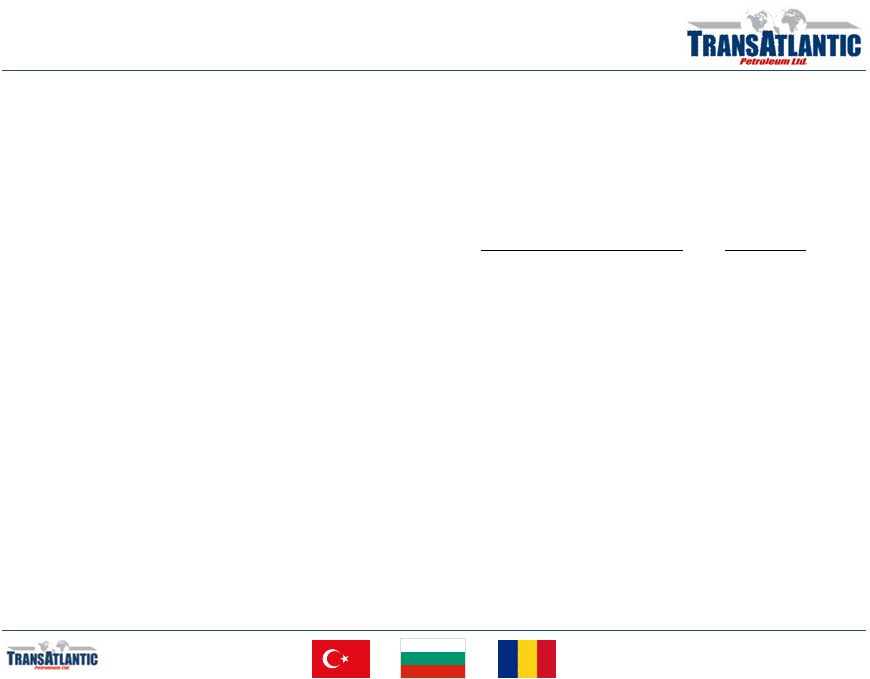 Forward Looking
Statements Outlooks,
projections,
estimates,
targets,
and
business
plans
in
this
presentation
or
any
related
subsequent
discussions
are
forward-looking
statements.
Actual
future
results,
including
TransAtlantic
Petroleum
Ltd.’s
own
production
growth
and
mix;
financial
results;
the
amount
and
mix
of
capital
expenditures;
resource
additions
and
recoveries;
finding
and
development
costs;
project
and
drilling
plans,
timing,
costs,
and
capacitie
s; revenue
enhancements
and
cost
efficiencies;
industry
margins;
margin
enhancements
and
integration
benefits;
and
the
impact
of
technology
could
differ
materially
due
to
a
number
of
factors.
These
include
changes
in
long-term
oil
or
gas
prices
or
other
market
conditions
affecting
the
oil,
gas,
and
petrochemical
industries;
reservoir
performance;
timely
completion
of
development
projects;
war
and
other
political
or
security
disturbances;
changes
in
law
or
government
regulation;
the
outcome
of
commercial
negotiations;
the
actions
of
competitors;
unexpected
technological
developments;
the
occurrence
and
duration
of
economic
recessions;
unforeseen
technical
difficulties;
and
other
factors
discussed
here
and
under
the
heading
“Risk
Factors"
in
our
Annual
Report
on
Form
10-K
for
the
year
ended
December
31,
2011
and
our
Quarterly
Report
on
Form
10-Q
for
the
quarter
ended
March
31,
2012
available
at
our
website
at
www.transatlanticpetroleum.com
and
www.sec.gov.
See
also
TransAtlantic’s
2011
audited
financial
statements
and
the
accompanying
management
discussion
and
analysis.
Forward-looking
statements
are
based
on
management’s
knowledge
and
reasonable
expectations
on
the
date
hereof,
and
we
assume
no
duty
to
update
these
statements
as
of
any
future
date.
The
information
set
forth
in
this
presentation
does
not
constitute
an
offer,
solicitation
or
recommendation
to
sell
or
an
offer
to
buy
any
securities
of
the
Company.
The
information
published
herein
is
provided
for
informational
purposes
only.
The
Company
makes
no
representation
that
the
information
and
opinions
expressed
herein
are
accurate,
complete
or
current.
The
information
contained
herein
is
current
as
of
the
date
hereof,
but
may
become
outdated
or
subsequently
may
change.
Nothing
contained
herein
constitutes
financial,
legal,
tax,
or
other
advice.
The
SEC
has
generally
permitted
oil
and
gas
companies,
in
their
filings
with
the
SEC,
to
disclose
only
proved
reserves
that
a
company
has
demonstrated
by
actual
production
or
conclusive
formation
tests
to
be
economically
and
legally
producible
under
existing
economic
and
operating
conditions.
We
may
use
the
terms
“estimated
ultimate
recovery,”
“EUR,”
“probable,”
“possible,”
and
“non-proven”
reserves,
“prospective
resources”
or
“upside”
or
other
descriptions
of
volumes
of
resources
or
reserves
potentially
recoverable
through
additional
drilling
or recovery
techniques
that
the
SEC’s
guidelines
may
prohibit
us
from
including
in
filings
with
the
SEC.
These
estimates
are
by
their
nature
more
speculative
than
estimates
of
proved
reserves
and
accordingly
are
subject
to
substantially
greater
risk
of
being
actually
realized
by
the
Company.
There
is
no
certainty
that
any
portion
of
estimated
prospective
resources
will
be
discovered.
If
discovered,
there
is
no
certainty
that
it
will
be
commercially
viable
to
produce
any
portion
of
the
estimated
prospective
resources.
BOE
is
derived
by
converting
natural
gas
to
oil
in
the
ratio
of
six
thousand
cubic
feet
(Mcf)
of
natural
gas
to
one
barrel
(bbl)
of
oil.
Boe
may
be
misleading,
particularly
if
used
in
isolation.
A
BOE
conversion
ratio
of
6
Mcf:
1
bbl
is
based
on
an
energy
equivalency
conversion
method
primarily
applicable
at
the
burner
tip
and
does
not
represent
a
value
equivalency
at
the
wellhead.
2 |
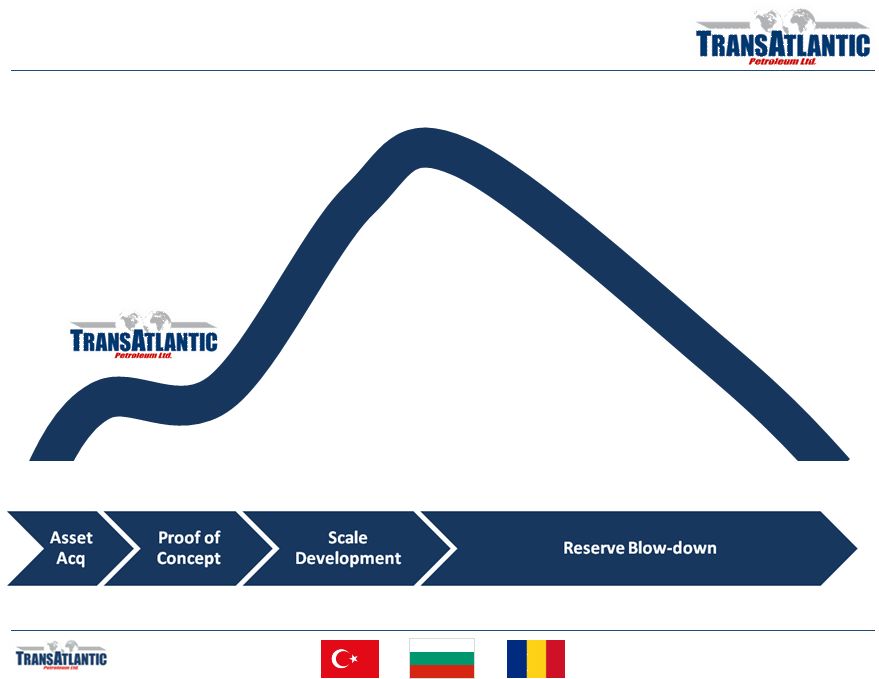 Oil and Gas Life
Cycle: Still Early Innings 3 |
 Road Has Been
Bumpy, But Still Holding Above Peers 4
Peer group inclusion factors: Publicly-traded company on 1/1/2008, meaningful onshore
presence in Eastern Europe, Middle East, and/or North Africa |
 5
Portfolio Overview |
 Portfolio
Overview 6 |
 Portfolio
Overview 7
Thrace Basin Development Taking Shape
•
Proved
the
rock
is
conducive
to
frac.
•
Deep
program
has
identified
an
additional
~1,000
meters
of
gas
saturated
sands.
•
Gearing
up
for
continuous
drill-and-frac
program
beginning
during
2H12.
New Resource Play Concepts in the Southeast
•
Goksu
discovery
showing
similar
properties
to
Mississippian
Lime
play
in
the
U.S.
•
Dadas
shale
evaluation
process
ongoing
and
picking
up
pace.
Offset
activity
could help
accelerate
the
learning
curve
process.
•
Horizontal
concept
on
Gaziantap
license.
Near-Term High Impact Exploration
•
Idil
block
holds
several
structures,
confirmed
with
recent
seismic.
Only
area
of
Turkey
with
same
drilling
targets
as
prolific
fields
in
Iraq
and
Syria.
•
Large
structure
identified
on
Gurun
license.
Longer-term Optionality
•
Bulgarian
and
Romanian
shales.
•
Turkish
exploration
acreage
(Sivas,
Adana,
other). |
 8
Thrace Basin |
 Thrace Basin Frac
Program: Play Concept & Strategy 9
Play Concept
•
Thick, stacked, blanket sands with significant gas in place.
•
Extensive well control from shallow production
•
Thermally mature, but largely untested, source rocks provide substantial unconventional
potential with the application of modern drilling and completion methods.
Assessment Strategy
1.
Prove rock is conducive to frac using low cost re-entries of existing shallow
wellbores. a.
Identify and test various zones (approximately 2,500-6,500 feet or 750-2,000
meters). b.
Determine appropriate mix of fluid and horsepower.
c.
Test multiple zone completions.
2.
Test deeper potential and additional structures with new wellbores
a.
Identify and test deeper zones (approximately 5,000-13,000 feet or 1,500-4,000
meters). b.
Test additional structures (Pancarkoy-1, Suleymaniye-2).
c.
Define opportunity set (number of productive zones, commingling potential, etc.).
3.
Test multi-stage vertical fracs
4.
Evaluate individual zone productivity for horizontal potential and test if/where
applicable. 5.
Evaluate off-structure (stratigraphic) potential of blanket sands.
In Process
In Process
In Process
In Process
Commencing
TBD
TBD |
 Thrace Basin
Frac Program: Play Concept & Strategy 10
Overview
•
Unconventional targets from
approximately 1,000 meters (~3,300
feet) to 4,000 meters (~13,100 feet).
•
Early activity provided support that
conventional sands to 1,500 meters
(~5,000 feet) were viable targets
with economic recoveries.
•
Deep activity to-date has expanded
the opportunity set with an
additional 1,000 meters (~3,300
feet) of gas saturated sands shown
to be productive.
•
Testing indicating that targets below
approximately 2,500 meters (~8,200
feet) are tight and water prone.
•
Finishing fourth deep well with
results expected to provide enough
detail to begin transition to
development program in the
Tekirdag Field Area. |
 Thrace Basin
Frac Program: Mezardere Members 11 |
 Thrace Basin
Frac Program: Type Curve Scenarios 12
•
3 cases/scenarios forecasted using 60 day average, normalized rate from 7 single
stage fracs
•
Average IP for the 7 fracs is 1,800 Mcf/d
•
Base Case is 330 MMcf, Average recovery of the 3 cases is ~370 MMcf
•
Production data thus far indicates steep initial decline with an
average hyperbolic
exponent of 1.3
Decline Curve Parameters and Scenarios
Case
EUR (MMcf)
b
Di
Qi
Low
250
1.1
91%
1,800
Base
330
1.3
89%
1,800
High
520
1.6
86%
1,800
Average
367
1.3
89%
1,800
Internal prospective resource estimates prepared 2/28/12 and evaluated by a registered
professional engineer in accordance with NI 51-101 guidelines and the COGE Handbook |
 Thrace Basin
Frac Program: Type Curve Economics 13
Cost Assumptions:
•
Well preparation, pre-frac diagnostics, one stage frac, and testing: $330k gross
•
Additional $400k gross investment to drill and case a 1,000m well. Each additional stage
expected to cost $90k per stage.
•
Gas price = $7.42/mcf
•
Base case recovery and decline parameters were used for each stage in New Drill cases
Remarks:
•
All re-entry cases payout in 1.5 months, recovering approximately 65 MMcf gross in the
first 2 months •
Approximately 20 re-entry candidates have been identified
•
The Low Case for a new drill with single stage still nets $280k NPV10 with a 0.9 ROI
Single Stage Re-Entry Economics
Case
NPV10
($M)*
ROI
Payout
(Mos)
Low
$450
3.3
1.5
Base
600
4.4
1.5
High
890
6.5
1.5
Average
$650
4.8
1.5
New Drill Economics –
Base Case Forecast
Case
NPV10
($M)*
ROI
Payout
(Mos)
1 Stage
$435
1.4
5.8
2 Stage
1,220
3.6
4.2
3 Stage
1,940
5.1
3.7
Average
$1,200
3.4
4.6
Internal prospective resource estimates prepared 2/28/12 and evaluated by a registered
professional engineer in accordance with NI 51-101 guidelines and the COGE Handbook
* Net to TransAtlantic’s 41.5% working interest
* Net to TransAtlantic’s 41.5% working interest |
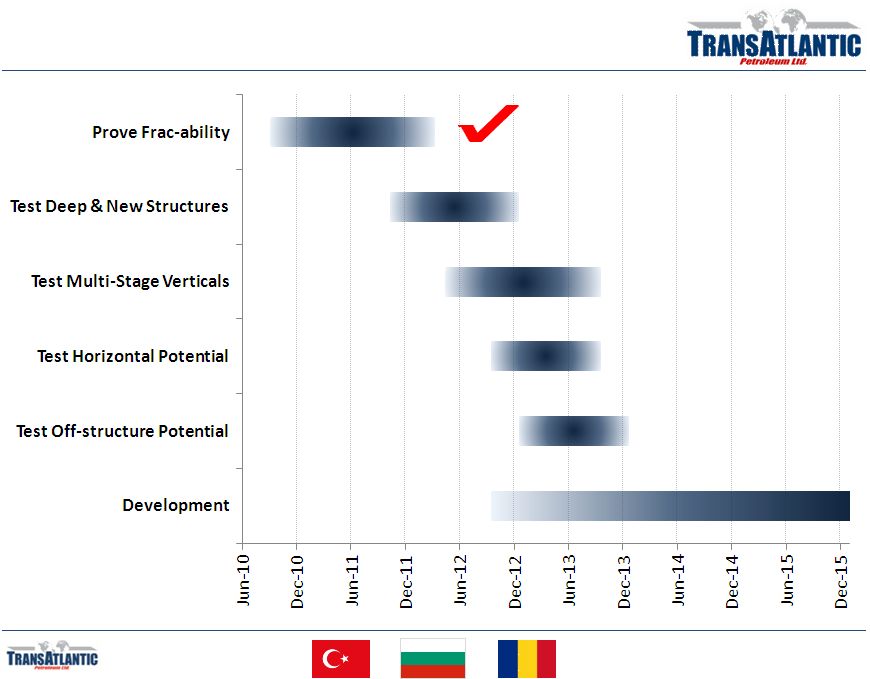 Thrace Basin
Frac Program: Assessment Timeline 14 |
 Thrace Basin
Frac Program: Assessment Limitations 15
Stimulation Equipment
•
Currently only a single frac spread in-country. If utilized to test deep Thrace
targets or to stimulate zones in southeast Turkey then the equipment is not
available for repeat development program completions in the Tekirdag area.
•
Viking’s second frac crew expected to be available during the first quarter of
2013. Additional equipment possible with further success.
Winter Weather Can Slow You Down
•
Winter conditions (wet) can inhibit activity, most notably pad construction and
equipment moves.
•
During assessment periods with activity contingent upon recent wells, can add
meaningful time between wells.
•
Development program allows advanced preparation of wellpads and logistics
planning for drilling and completion materials. |
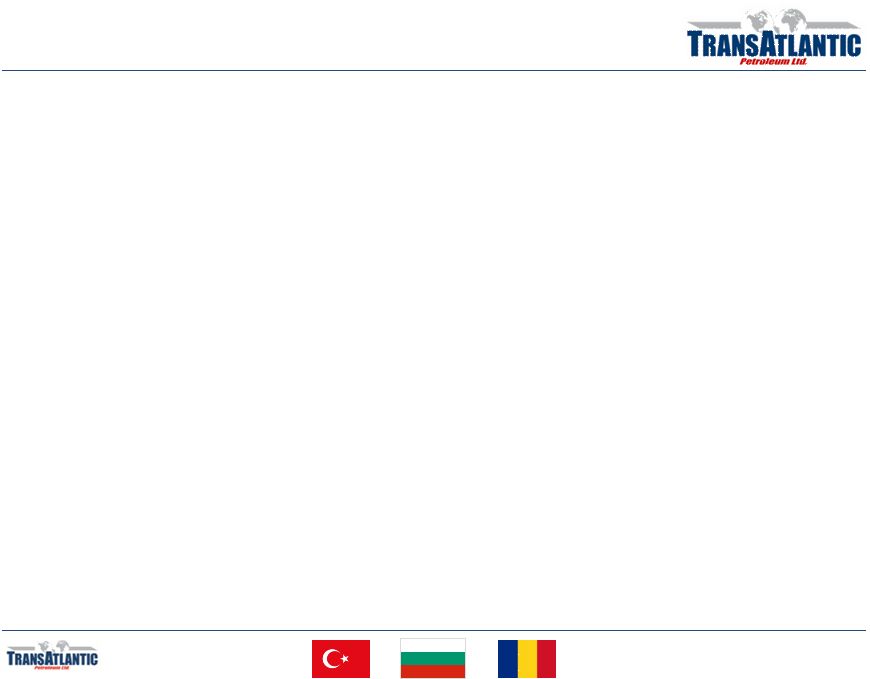 16
Southeast Turkey |
 17
Overview
•
Extension of prolific Iraqi and Syrian oil
trends. Houses Turkey’s most
productive fields including
TransAtlantic’s Selmo field.
•
Conventional oil production provides
low decline base.
•
Conventional and unconventional
upside opportunities including large
shale play potential. Numerous large
anticlines identified.
•
Bedinan, Dadas, Hazro, and Mardin
targets.
•
Existing production reasonably well
removed from border.
•
Recent seismic shoot at Idil block along
Syrian border. Drilling expected later in
2012.
Dadas Shale
•
Upper Silurian (Woodford equivalent)
•
Roughly equal in size to the Barnett.
•
Source rock for conventional fields.
•
Limited test work to-date. Early work
indicates oil, liquids and gas windows.
Turkey: Southeast |
 Southeast
–
Dadas
Shale
Overview
18
Dadas
Shale Characteristics
•
Devonian-Silurian age .
•
Areal extent similar to the core area of the Barnett shale.
•
Basal member (Dadas
1) is the primary oil source rock for regional
hydrocarbon production.
•
Indications of oil window (south) transitioning to gas window (north).
•
TransAtlantic’s acreage primarily in expected oil and liquids windows.
Goksu-1R Core Analysis
•
Approximately 30 feet of core taken (2010).
•
Vertical depth: 8,350 feet (2,500 meters)
•
Total Organic Content: 7-9%
•
Porosity: 0.5-6.0%
•
T
max
:
435°
C
•
R
0
: 0.7-0.8%
Shale Comparison
Attribute
Dadas
Woodford
Eagle Ford
Bakken
Age
Silurian
Silurian
Cretaceous
Mississippian
Depth (ft)
7,000-10,000
6,000-14,500
4,000-14,000
8,000-11,000
Gross Thickness
300-800
300-400
100-350
150
TOC (%)
3.0-12.0
6.0-6.5
4.0-5.5
6.0-8.0
T
max
(°
C)
350-460
300-400
425-455
420-430
R
0
(%)
0.5-1.0%
1.1-3.0%
0.5-2.6%
0.4-1.7%
Porosity (%)
0.5-10%
3-12%
4-15%
8-12%
Permeability
0.3-1.0 md
0.2 md
<0.13 md
0.005-0.2 md
Oil Gravity (API)
40-60
30-65
40-60
40-45
EUR (Mboe)
TBD
150-2,000
300-1,500
500-1,500 |
 Southeast
–
Dadas
Shale
Isopach
19
TransAtlantic’s
Molla Field
TransAtlantic’s
Arpatepe Field
TransAtlantic’s
Selmo Field
TransAtlantic
Recent License
Award |
 Southeast
–
Dadas
Shale
Industry
Interest
20
Shell/TPAO
Dadas Joint Venture
TransAtlantic’s
Molla Field
TransAtlantic’s
Arpatepe Field
TransAtlantic’s
Selmo Field
TransAtlantic
New Exploration
License
Anatolia Energy
Dadas Core
TPAO
Dadas Test Well
TransAtlantic’s
Bahar-1
TransAtlantic’s
Goksu 1 & 2 |
 Southeast
– Molla/Goksu
21
Concept Overview
•
Previously
by-passed
pay
zone.
•
Parallel,
vertically
oriented
natural
fracture
system.
•
Vertical
well
results
highly
dependent
upon
intersecting
a
fracture
and
the
ultimate
volume
capacity
of
the
fracture
itself.
•
Horizontal
concept
to
connect
vertical
fracture
system
in
similar
fashion
to
the
horizontal
Mississippian
Lime
play
in
Oklahoma
and Kansas. |
 Southeast
– Molla/Goksu –
Goksu 2 Production
22 |
 23
Near-Term
High-Impact
Exploration |
 Exploration:
Idil License - Southeast Turkey
24
Overview
•
Extension of prolific Iraqi and Syrian oil
trends. One of only a handful of
Turkish licenses with similar targets as
those seen in Syria and Northern Iraq.
•
High risk, high potential reward targets
identified with application of improved
seismic technology.
•
Unrisked potential greater than 100
MMbbls
(1)
.
•
Smaller target to spud during 4Q12.
•
Larger target to spud in 2013 after
winter conditions ebb.
(1) Internal estimate -
represents potentially recoverable
hydrocarbons from undiscovered accumulation(s) which
are subject to both risk of discovery and development. |
 Exploration:
Idil
License
–
2D
Seismic
Lines
25 |
 Exploration:
Idil License – Seismic Quality Improvement
26
2008 Single Receiver Line
Conventional Acquisition
(Post-stack Migration)
2012 Dual Receiver Line
Combined Sweep Acquisition
(Pre-stack Migration) |
 Exploration:
Idil License – Ebyat Anticline (Ukok-1)
27 |
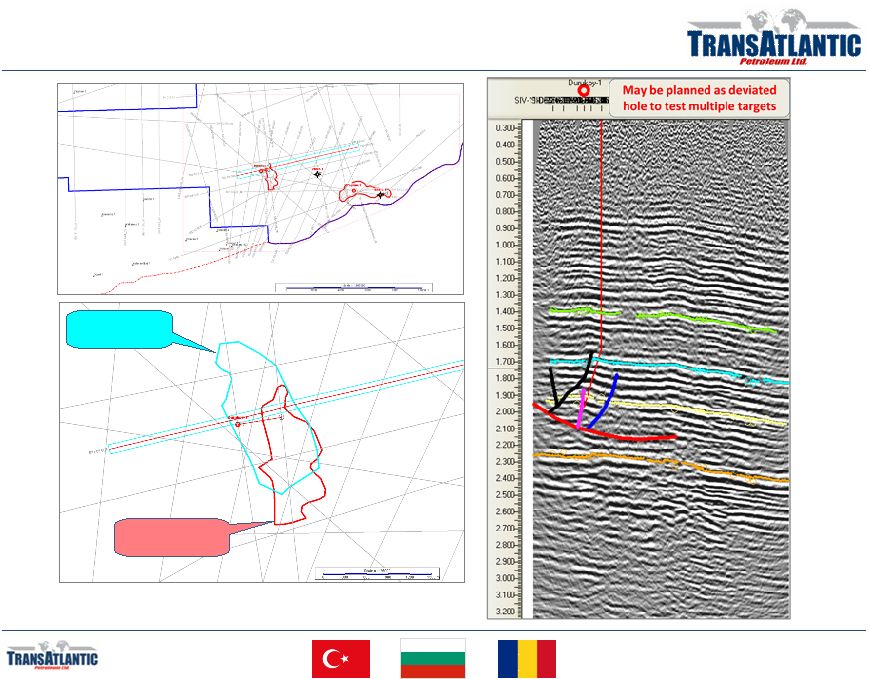 Exploration:
Idil License – South Area (Durukoy-1)
28
Cudi Closure:
400 acres
Mardin Closure:
250 acres |
 Exploration:
Gurun License - Central Turkey (Konak-1)
29
Overview
•
Large structure identified.
•
High-risk, high potential reward. Single
well should assess structure’s viability
as a target.
•
Activity expected during 3Q12. |
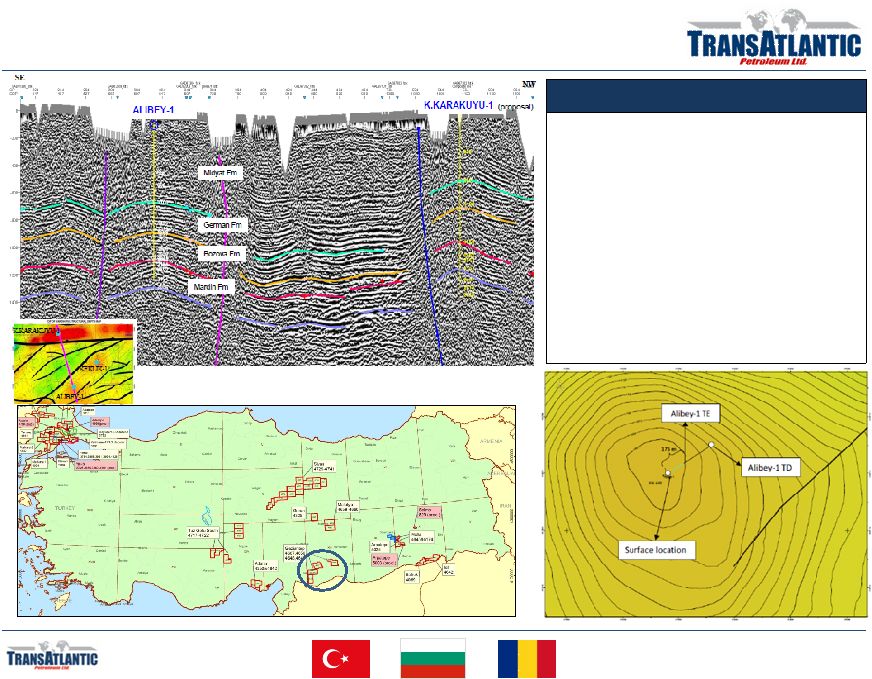 Exploration:
Gaziantap License – S. Central (Alibey-1H)
30
Overview (Alibey-1H)
•
Re-entry of vertical oil show well.
•
Mardin target with similar geologic
characteristics as those seen at
Molla/Goksu and the horizontal
Mississippian Lime play in Oklahoma and
Kansas.
•
Spud expected during 3Q12. |
 31
Longer-Term Optionality |
 Bulgaria
32
Overview
•
The A-Lovech exploration license covers approximately
565,000 acres (2,288 square kilometers) in NW Bulgaria.
•
All acreage is prospective for the Etropole shale formation.
•
Proximal to existing natural gas infrastructure.
•
Attractive terms: 2.5%-30% royalty and 10% corporate tax.
Koynare (Deventci)
•
160,000 acres (648 square kilometers)
•
Conventional gas discovery in the Jurassic-aged Orzirovo.
•
Deventci R-1, is currently producing ~250 Mcf/d on a limited
test basis. Waiting on award of production license. Surface
casing set on Deventci-R2.
•
Seeking a development partner.
Bulgaria’s Energy Profile
2010 Population:
7,561,910
2010 GDP:
$47.7 billion
2010 Oil Consumption:
91.0 Mbbls/d
2010 Oil Production:
2.9 Mbbls/d
2010 Nat Gas Consumption:
211 MMcf/d
2010 Nat Gas Production:
0 MMcf/d
Source: The World Bank, CIA World Factbook & Energy Information Administration
Peshtene R-11
•
November 2011 drilled a ~10,500 foot (3,200 meter)
exploration well to core and test the Etropole formation.
•
Core currently being evaluated.
•
Rock properties similar to prolific US shale plays, with more
favorable terms (royalty and taxes) and commodity pricing.
•
Etropole position is estimated to hold gross unrisked best
estimate prospective resources of 11 Tcfe
(1)
.
•
Awaiting revision(s) to recent Parliamentary legislation.
(1) Internal estimate prepared as of November 2010 -
represents potentially
recoverable hydrocarbons from undiscovered accumulation(s) which
are subject to
both risk of discovery and development. |
 Romania
33
Overview
•
50% interest in 1,000,000 acres (400,000 with
unconventional potential)
•
Sterling Resources-operated joint venture. Seeking
additional joint venture partner(s).
•
Prospective for Silurian shale (natural gas). Also holds
Jurassic oil potential.
•
Awarded license for Phase 2 Exploration Period.
•
Remaining commitment of 200 km 2D seismic to be shot
during 2012.
•
Chevron has acquired exploration licenses straddling the
eastern Bulgarian/Romanian border.
Romania’s Energy Profile
2010 Population:
21,449,980
2010 GDP:
$161.6 billion
2010 Oil Consumption:
196.0 Mbbls/d
2010 Oil Production:
107.1 Mbbls/d
2010 Nat Gas Consumption:
1,247 MMcf/d
2010 Nat Gas Production:
1,025 MMcf/d
Source: The World Bank, CIA World Factbook & Energy Information Administration
(EIA) |
 Sivas Basin
– Central Turkey
34
Overview
•
Large, unexplored basin. Only one well
ever drilled.
•
Basin-edge analysis shows source rock,
reservoir rock and seal rock potential.
•
Exploration Agreement with Shell
covering TransAtlantic’s 1.6 million
acres.
2012 work program: Seismic and
aeromagnetic studies.
2013 work program: Up to two
wells, contingent upon seismic and
aeromag. |
 Hedge
Profile 35
As
of
3/31/2012 |
 PV10
Reconciliation 36
The
PV-10
value
of
the
estimated
future
net
revenue
are
not
intended
to
represent
the
current
market
value
of
the
estimated
oil
and
natural
gas
reserves
we
own.
Management
believes
that
the
presentation
of
PV-10,
while
not
a
financial
measure
in
accordance
with
U.S.
GAAP,
provides
useful
information
to
investors
because
it
is
widely
used
by
professional
analysts
and
sophisticated
investors
in
evaluating
oil
and
natural
gas
companies.
Because
many
factors
that
are
unique
to
each
individual
company
impact
the
amount
of
future
income
taxes
estimated
to
be
paid,
the
use
of
a
pre-tax
measure
is
valuable
when
comparing
companies
based
on
reserves.
PV-10
is
not
a
measure
of
financial
or
operating
performance
under
U.S.
GAAP.
PV-10
should
not
be
considered
as
an
alternative
to
the
standardized
measure
as
defined
under
U.S.
GAAP.
The
following
table
provides
a
reconciliation
of
our
PV10
to
our
standardized
measure:
US $ thousands
Total PV 10:
$645,837
Future income taxes:
(171,592)
Discount of future income taxes at 10% per annum:
57,522
Standardized measure:
$531,797 |
